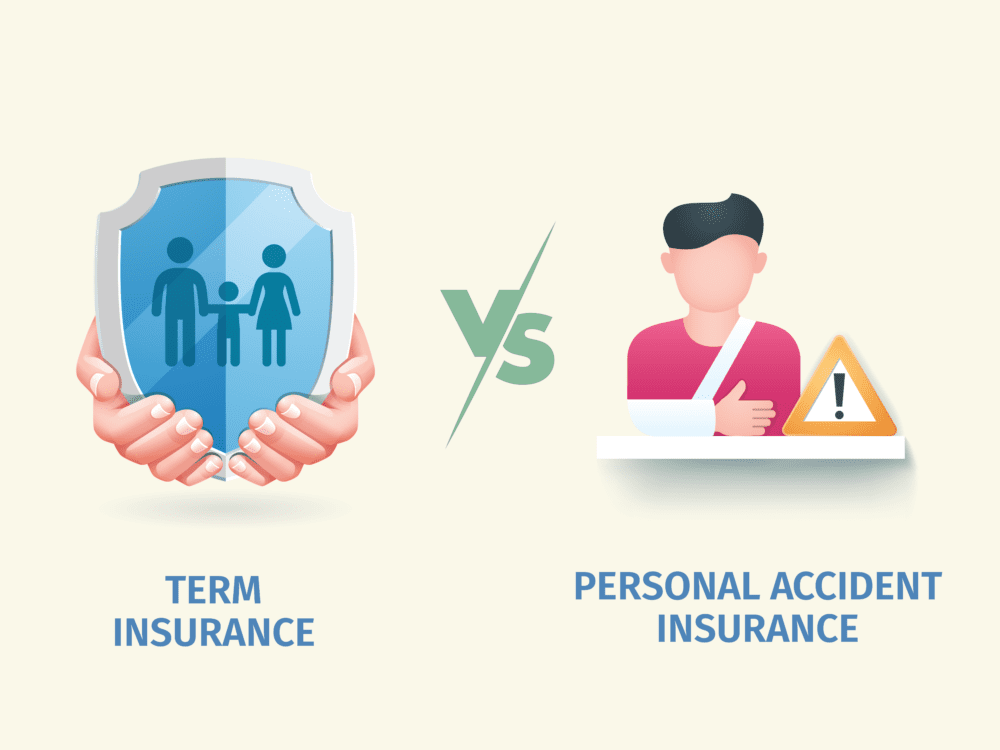Life and Health Protection are the major two areas to look for in insurance planning; Life protection through term insurance and health protection through health insurance plays a vital role in managing the risks, creating financial security for loved ones and save out of pocket expenses should an uncertainty arise.
Let us understand about Life Protection through Term Insurance here,.
What is Term Insurance?
Term Insurance is the oldest, cheapest, and purest form of risk protection. It provides financial security to the family in your absence against a fixed premium paid for a specified term. The nominee receives the death benefit in Lumpsum amount called Sum Assured in case of the unfortunate death of the policyholder during the policy term.
If the person survives till the term, nothing is paid back as the very purpose of the policy is to provide Life protection till the specified term by taking the risk charges (called the premium). Hence, there is no maturity benefit available in the policy.
The term plan covers any kind of death, anywhere in the world except for Suicide within the first year.
Given the varied products and complex terminologies for the layman, it is apparent to understand what factors to consider before choosing the Term insurance plans;
Here are 6 Factors to consider before choosing Term Insurance
Identify the right Coverage needs:
Before buying a term insurance policy, it’s important to assess your coverage needs.
Consider factors such as your family’s living expenses, outstanding loans, and future financial goals to arrive at Mortality Gap. The Sum assured should be sufficient to cover your family’s expenses in case of an unfortunate event.
To explain it further,
How much cover do I need?
The purpose of term insurance is to ensure a similar lifestyle for dependents in case of the sudden demise of the insured life.
This essentially means that the size of term insurance should be able to replace the income of the insured lives to the extent the income was used to meet expenses and service outstanding liabilities like existing loans. This depends on which life stage you are in to and your persona as mentioned above.
The best way to calculate the size of term insurance is to estimate the size, type, and timing of the expenses along with the size of outstanding liabilities and macroeconomic factors like investment returns on various asset classes, inflation rates, tax rates, etc.
using the Need-Based Approach
The whole idea is to ensure the Mortality protection gap is identified and the risk is mitigated.
Choose the right policy Tenure:
The policy term should be chosen based on your age, retirement age, and financial goals.
How one decides on policy tenure shall primarily depends on selecting any one of the following two approaches and understanding why one need Term insurance;
Creating an Asset to Pay off Debt/Liability
For this approach, the policy tenure shall be to cover the policyholder till age 60/65 years of age. Which means, Policy Tenure = (65years) – (the current age)
Given the rationale that, one should take Term till the person earns a “Regular Income” and Debt and Liabilities or responsibilities towards family are aligned towards this tenure.
Creating a Financial Estate for loved ones
For this approach, the policy shall be to cover the policyholder till age 75 to 85 years giving rationale about Life expectancy and align with the objective of buying Term for leaving an estate for family and create financial independence for them which will help them maintain the same standard of living, etc.
The Policy tenure= (85years) – (the current age)
Remember: Liability management to attain financial freedom
When a substantial financial corpus has been attained to achieve the financial goals and be able to provide the same standard of living to the family even when in your absence, one can opt out of Term insurance as all the financial responsibilities are accomplished.
Understand which Riders to add:
Riders are add-on benefits that can enhance your policy coverage. Waiver of premium on critical illness and disability can be added along with the base term plan.
This rider provides you with a premium holiday from the date or diagnosis of the listed critical illness or should a permanent disability arise due to accident. This ensures that Term insurance covers 3 D’s death, diseases, and disablement.
For all other riders such as Accident Death Benefit Rider, Critical illness Rider, etc. it is advisable to evaluate the exact purpose and study the difference between adding it with base Term plan or buy a standalone offering for its comprehensiveness.
Evaluate the premium amount:
Pricing plays a key role as it should justify the value that you derive from the products.
The premium amount should also be affordable and sustainable for the entire policy term. It depends on your age, policy tenure, etc. One should be mindful of the same and consider the needs are also in line with income, budget, and other financial obligations while choosing the plan.
Brand Evaluation:
This parameter evaluates the financial strength and stability of the insurance company providing the term insurance policy.
Solvency Ratio is a financial metric that indicates an insurance company’s ability to meet its long-term financial obligations. The Persistency Ratio for 13th and 61st month measures the percentage of policyholders who continue to pay premiums after 13 and 61 months, respectively. The Claim Settlement Ratio is the percentage of claims that an insurance company has settled in a given period.
It’s important to research the Brand reputation, evaluate the financial strength and stability of the insurance company providing the term insurance by studying certain financial ratios such as Solvency ratio, persistency ratio, commission ratio and claim settlement ratio.
Solvency Ratio is a financial metric that indicates an insurance company’s ability to meet its long-term financial obligations. The Persistency Ratio for 13th and 61st month measures the percentage of policyholders who continue to pay premiums after 13 and 61 months, respectively. The Claim Settlement Ratio is the percentage of claims that an insurance company has settled in a given period.
You should choose a company that has a good reputation, a strong financial position in the market, and a high claim settlement ratio.
Claims Experience
This factor helps you evaluates the insurance company’s track record when it comes to paying out claims, what is the frequency with which they settle claim, no. of complaints they received per 10,000 claims, etc.
Ageing of Claims evaluates the average time taken by the insurance company to settle claims. The Claims Paid ratio is the number of claims paid by the insurance company in a given period. The No. of Claims per 10,000 complaints is a metric that evaluates the number of claims registered per 10,000 customer complaints received by the insurance company.
These above 6 points guide which will help you choose a policy that provides adequate coverage, is affordable, comes with the necessary riders, and helps make informed decisions which provides value for money and cater to individual needs.
Some of the popular term insurance plans available in India are as under:
| Insurer Name | Plan Name |
| Max Live Insurance Company Limited | HDFC Life- Click 2 Protect Plus |
| HDFC Life Insurance Company Limited | TATA AIA- Sampoorna Raksha Supreme |
| TATA AIA Life Insurance Company Limited | Max Life-Smart Secure Plus |
| Bajaj Allianz Life Insurance Company Limited | ICICI Pru- iProtect Smart |
| Aditya Birla Sun Life Insurance Company Limited | Bajaj Allianz-e-touch term plan |
| ICICI Prudential Life Insurance Company Limited | ABSLI DigiShield Plan |
One must evaluate these based on the above factors before purchasing and read out all policy terms and conditions on the product or reach out to your qualified financial advisor for your financial well-being journey.









